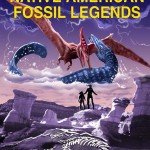By Adrienne Mayor (Regular Contributor)
 The most well known scientific name for a dinosaur derived from Native American culture is Brontosaurus, a tremendous 60-foot long sauropod described by Othniel Marsh in 1879. The name means “Thunder Lizard,” in honor of the Sioux fossil scouts who showed Marsh the colossal skeletons of extinct creatures they called “Thunder Beasts.”
The most well known scientific name for a dinosaur derived from Native American culture is Brontosaurus, a tremendous 60-foot long sauropod described by Othniel Marsh in 1879. The name means “Thunder Lizard,” in honor of the Sioux fossil scouts who showed Marsh the colossal skeletons of extinct creatures they called “Thunder Beasts.”
Native Americans led many paleontologists to world-famous deposits of dinosaur and other prehistorical animals in the American West, beginning in the 19th century. The guides explained their tribes’ mythology and knowledge of the strange, gigantic beings that once flourished and then vanished, leaving their stony remains in the ground.
This historical cultural exchange resulted in numerous American Indian myths, names, legends, and lore about dinosaurs and other extinct species commemorated in scientific nomenclature for fossils. Sioux languages are well represented. Examples include Iguanodon lakotaensis (a Cretaceous dinosaur); the large rodents Manitsha tanka, Campestrallomys siouxensis, and Hitonkala; the hippo-like anthracothere Kukusepasutanka, and the fossil mammal Ekgmoiteplecela. Paleontologist J. Reid MacDonald bestowed Lakota Sioux designations on several Oligocene mammals of the White River Badlands, such as Sunkahetanka, “dog with large teeth.” The name Ekgmowechashala for the primate fossil discovered near Wounded Knee, Pine Ridge Reservation, is Sioux for “monkey” or “little cat man.” A new species of Jurassic apatosaur was discovered in 1994 in Wyoming, the first sauropod dinosaur with a complete set of “belly ribs.” The paleontologists named the dinosaur Yahnahpin because they noticed that the ribs bear a striking resemblance to Lakota Sioux warriors’ chest armor, mah-koo yah-nah-pin (“chest necklace”).
In 1873, Joseph Leidy named a fossil carnivore Sinopa, the Blackfeet word for “small fox.” In 1989 in northern Montana, R. Lund named a new petalodontiform chondrichthyian fossil Siksika (“black foot”) for the Blackfeet nation.
Quetzalcoatlus, the giant pterosaur, was named after the Aztec Feathered Serpent god. The pterosaurs Tupuxuara and Tapejara are names of spirits in Tupi mythology of Brazil. The theropod dinosaur Ilokelesia of Patagonia comes from Mapuche words ilo (flesh) and kelesio (lizard), and the tyranosauroid Megaraptor namunhuaiquii is Mapuche for “foot lance.”
Douglas Wolfe dubbed the new horned dinosaur Zuniceratops to honor the Zuni on whose land the fossils were discovered. A Cretaceous marsupial of the Southwest is named Kokopelia after the familiar flute-playing figure Kokopeli in Navajo rock art. Two hadrosaur dinosaurs of the San Juan Basin, New Mexico, Naashoibitosaurus and Anasazisaurus, are part of the taxonomic nomenclature associated with Kritosaurus navajovius, named by Barnum Brown in 1910.
The enormous marine reptile Tylosaurus nepaeolicus/Liodon nepaeolicus (first described by Edward Drinker Cope in 1874), was found in the gray shale of the Solomon River in Kansas. The species name comes from “Nepaholla,” the Pawnee name for the Solomon River.
NOTE. Thanks to all my paleontologist friends who supplied examples of Indian languages preserved in fossil species’ scientific names. For the history of Native American discoveries and interpretations of dinosaur and other fossils, see my book “Fossil Legends of the First Americans” (2005).
